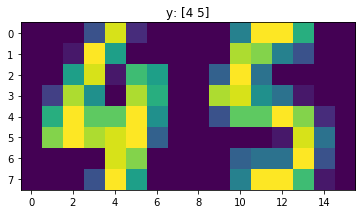%tensorflow_version 2.x
import tensorflow as tf
from tensorflow import keras
import numpy as np
import matplotlib.pyplot as plt
from sklearn.datasets import load_digitstf.keras.backend.set_floatx('float32')x, y = load_digits(return_X_y=True)
x.shape, y.shape, set(y)▶ 학습데이터와 테스트 데이터를 나눕니다
m = len(y)//2
x_train = x[:m]
y_train = y[:m]
x_test = x[m:m*2]
y_test = y[m:m*2]
x_test.shape, y_test.shape((898, 64), (898,))
def convert_2_num(x_test, y_test):
x_test = np.reshape(x_test, [-1, 8, 8])
x_test_l, x_test_r = np.split(x_test, 2, axis=0)
x_test_lr = np.concatenate((x_test_l, x_test_r), axis=2)
y_test_l, y_test_r = np.split(y_test, 2, axis=0)
y_test = np.stack((y_test_l, y_test_r), -1)
#우측에 비어있는 이미지를 붙여서 한자리수 데이터를 만듭니다
BLANK = 10 #'없음' 을 나타내는 기호
x_test_blank = np.concatenate((x_test_l, np.zeros_like(x_test_r)), axis=2)
y_test_blank = np.stack((y_test_l, np.zeros_like(y_test_l) + BLANK), 1)#좌측 영상의 y와 빈 영상의 y를 통합
#두자리수 데이터와 한자리수 데이터를 통합합니다
x_test_set = np.concatenate((x_test_lr, x_test_blank), 0)# 두자리수 영상과 한자리수 영상을 통합
y_test_set = np.concatenate((y_test, y_test_blank), 0)#두자리수 y와 한자리수 y 를 통합
return x_test_set, y_test_set x_test_set, y_test_set = convert_2_num(x_test, y_test)
x_train_set, y_train_set = convert_2_num(x_train, y_train)i = 11
plt.title('y: '+str(y_test_set[i]))
plt.imshow(x_test_set[i].reshape((8,-1)))
class MyModel(keras.Model): # github.com/sogangori/choongang20/
def __init__(self):
super(MyModel, self).__init__()
self.k = 10+1 # 클래스 갯수
self.seq = 2 # 자릿수
self.opt = tf.optimizers.SGD(learning_rate=0.01)#Stochatic Gradient Descent 확률적 경사 하강
self.conv0 = keras.layers.Conv2D(16, [3,3], padding='same', activation=keras.activations.relu)
self.conv1 = keras.layers.Conv2D(32, [3,3], padding='same', activation=keras.activations.relu)
self.pool0 = keras.layers.MaxPool2D([2,2], padding='same')
self.pool1 = keras.layers.MaxPool2D([2,2], padding='same')
self.rnn = keras.layers.LSTM(units=self.k, return_sequences=True)
def call(self, x):
#x (1797, 64)
x_4d = tf.reshape(x, [-1,8,8*2,1])
x_4d = tf.cast(x_4d, tf.float32)
net = self.conv0(x_4d)
net = self.pool0(net)#(4,8,16)
net = self.conv1(net)
net = self.pool1(net)#(2,4,32)
net = tf.reduce_sum(net, axis=1)# (4,32) 4개의 시퀀스
h = self.rnn(net)#(4,11) 4개의 output
h = h[:, 2:] # 앞에 2개의 output은 버리고 뒤의 2개의 output만 사용
h = tf.nn.softmax(h, axis=2)
return h
def get_loss(self, y, h):
#학습할때 nan이 발생하는 경우 값을 clip(자르다) (최소값, 최대값)
h = tf.clip_by_value(h, 1e-8, 1 - 1e-8) # h 가 0이나 1이 되지 않도록 하는 안전장치
cross_entropy = - (y * tf.math.log(h) + (1 - y) * tf.math.log(1 - h))
loss = tf.reduce_mean(cross_entropy)
return loss
def get_accuracy(self, y, h):
predict = tf.argmax(h, -1)
is_equal = tf.equal(y, predict)
self.acc = tf.reduce_mean(tf.cast(is_equal, tf.float32)) # True > 1, False > 0 로 cast
self.acc_all = tf.reduce_mean(tf.cast(tf.reduce_all(is_equal, axis=1), tf.float32))
def fit(self, x, y, epoch=1):
# x : (m, 8, 16), y: (m, 2)
y_hot = tf.one_hot(y, depth=self.k, axis=-1)#(m, 2, 10)
for i in range(epoch):
with tf.GradientTape() as tape: #경사 기록 장치
h = self.call(x)
loss = self.get_loss(y_hot, h)
grads = tape.gradient(loss, self.trainable_variables) #경사 계산
#경사가 너무 크면 nan 이 될 수 있으므로 gradient cliping (최소,최대값 제한) 을 합니다
grads = [(tf.clip_by_value(grad, -5.0, 5.0)) for grad in grads]
self.opt.apply_gradients(zip(grads, self.trainable_variables)) # 가중치에서 경사를 빼기
self.get_accuracy(y, h)
if i%10==0:
print('%d/%d loss:%.3f acc:%.3f acc_all:%.3f'%(i, epoch, loss, self.acc, self.acc_all))
model = MyModel()0/5000 loss:0.309 acc:0.067 acc_all:0.009
10/5000 loss:0.309 acc:0.069 acc_all:0.010
20/5000 loss:0.308 acc:0.070 acc_all:0.010
30/5000 loss:0.307 acc:0.071 acc_all:0.009
40/5000 loss:0.307 acc:0.076 acc_all:0.010
50/5000 loss:0.306 acc:0.079 acc_all:0.012
4970/5000 loss:0.243 acc:0.547 acc_all:0.275
4980/5000 loss:0.243 acc:0.547 acc_all:0.274
4990/5000 loss:0.243 acc:0.547 acc_all:0.274
# 테스트셋의 성능
h = model(x_test_set)
model.get_accuracy(y_test_set, h)
print('개별정확도',model.acc.numpy(),'두자리 모두 맞춘 정확도', model.acc_all.numpy())→ 개별정확도 0.51726055 두자리 모두 맞춘 정확도 0.24387528
'Deep learning > Code' 카테고리의 다른 글
| .mat 파일 읽어오기 (0) | 2020.01.31 |
|---|---|
| numtest (0) | 2020.01.31 |
| cnn_2_number_with_blank (0) | 2020.01.30 |
| cnn_2_number (0) | 2020.01.30 |
| keras_cnn_expert (0) | 2020.01.30 |
